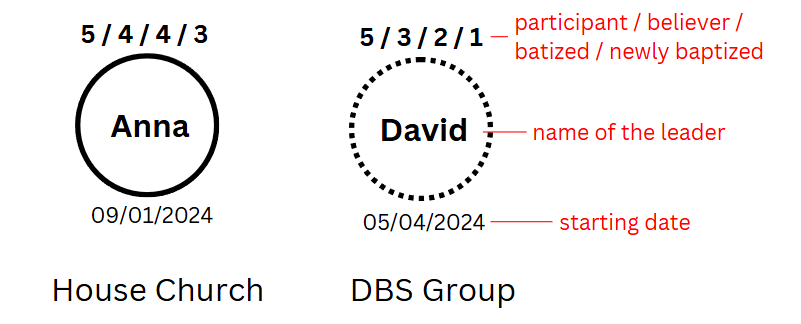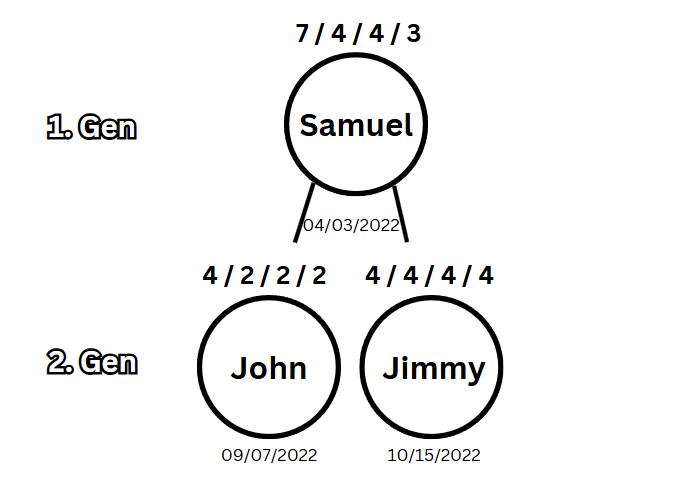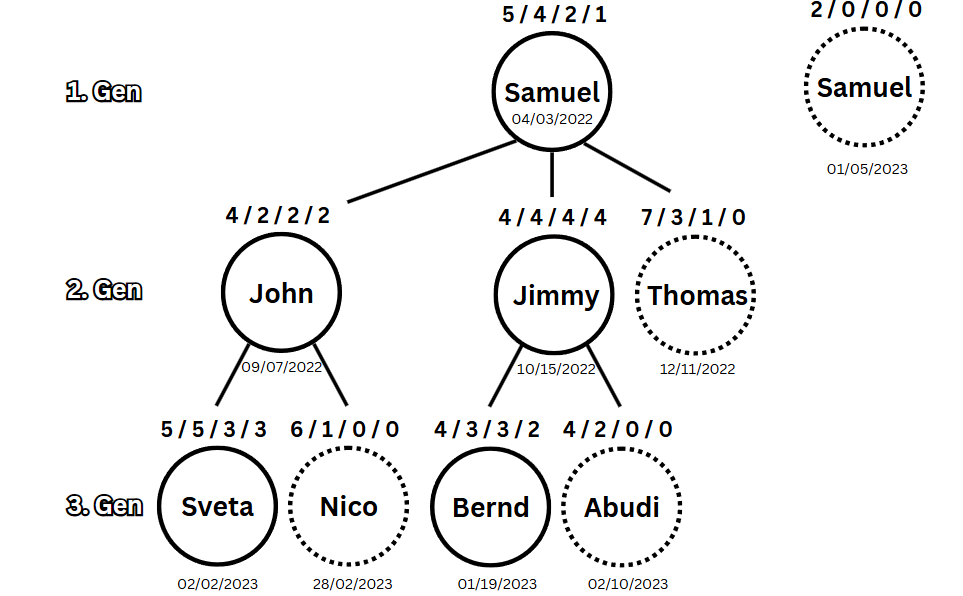What is the "Generational Map"?
A healthy church leads to multiplication. It is therefore only a matter of time before new churches are formed from the original church. To get a helpful overview of the movement and its health, the “Generational Map” tool (also known as a church tree, gene mapping, generational map or generation map) is suitable. It is designed to help leaders in a movement to categorize the growth around them and identify needs as easily as possible. For example, a generational map shows where multiplication has stalled and where training is still needed in certain areas.
The Generational Map provides a clear overview of all the churches that have been created by an original church. This shows how many generations have been multiplied so far, how many leaders are working independently and how many people have come to faith.
Why is this information so important?
Healthy leaders create healthy churches. Healthy churches multiply. The indicator for healthy church life is therefore fruitfulness. Many indicators can be determined on the basis of fruitfulness, which help in mentoring and coaching to keep an eye on the condition of each church and to promote it.
Elements of a circle
Each circle symbolizes a group. A dotted circle stands for a discovery Bible study group (Bible reading group). If some people from the group have been baptized and the group sees itself as a church, it becomes a solid circle, a house church.
Each circle has the following key information:
- Name of the leader (= initiator)
- Start date of the group
- Number of people who regularly come to the group
- Number of believers in the group
- Number of people baptized as adults
- Number of newly baptized

How to get started
A man called Samuel has been shown how to make disciples by the Holy Spirit using the Bible. He is already accompanying Thomas, who wants to support him on his way to reach new people and learn from Samuel. Thomas has already been baptized.
Samuel talked to his work colleague Jimmy about Jesus. Jimmy showed interest and wanted to read the Bible together with Samuel and Thomas. Jimmy brought his brother John and his neighbor Stephen to the first meeting. So their first Bible study group consisted of Samuel (leader), an already baptized person (Thomas) and 3 others (Jimmy, John, Stephen) who were neither baptized nor actively open to Jesus.
Their first meeting took place on 04/03/2022 [American spelling – MM/DD/YYYY]. This is the Bible study group of Samuel (not counted himself) in the Generation Map:

From bible study group to house church
In time, Jimmy also took his wife Lea with him. It wasn’t long before Jimmy, Lea and John understood who Jesus was, turned their backs on their old lives and were baptized. Stephen is still not quite sure whether he can trust this Jesus.
During a discovery Bible study session on Acts 2:36-47, Samuel asks the three (Thomas, Jimmy and John) what prevents them from seeing themselves as a church when they also live out all the elements of the first church?
Together they discussed what the Bible understands by church, what it means to live together as a family and to build relationships outside of meetings. They also shared the vision of Jesus and that they wanted to fulfill this mission together. This was the start of a stable 1st generation church.

The second generation of church
Jimmy loved Jesus and couldn’t keep his experience with him to himself. He shared the gospel with many people for weeks, but it took a few months for it to continue. Suddenly his cousin Tim opened up to Jesus. Instead of taking Tim to Samuel’s house church, Jimmy started meeting with Tim alone to read the Bible. After just a few weeks, Tim took his girlfriend Sara with him. His father Benni and sister Nina also wanted to take a look.
When they were all baptized together after a few more months, the joy was great. Jimmy was allowed to baptize someone for the first time in his life. And then 4 at once!
Samuel was still present at this baptism and just watched with joy. Even though Samuel had never been part of this group, he continued to prepare Jimmy well for leading this group and baptizing the others. But Jimmy had actually experienced first-hand with Samuel how it all worked. This made it all the easier for him.
John had also had similar experiences and was able to baptize 2 people during this time. They were also able to talk about the topic of “church” and made a commitment to each other.
In the meantime, Samuel has been joined by 2 new people who have only recently become interested in Jesus and Samuel’s capacity would not be sufficient to meet with them alone.

A new stream
In the meantime, Samuel’s neighbors have also opened up to Jesus. He has started to read the Bible with them. Instead of continuing in Samuel’s existing generational sequence, a new branch begins because Samuel is involved again.
With Jimmy and John, two new leaders have also emerged who have already made a new start in their environment. One of these groups sees itself as a church and contains newly baptized members.
For Jimmy and John, it makes no sense to continue coming to Samuel’s meetings due to their limited experience. They have been sent out. Samuel continues to train them in a separate leadership team. Thomas is also already a part of this team to deepen leadership topics.

Goals
The goal in multiplicative discipleship is that each new generation of disciples also becomes a new generation of church. However, this only happens when the leader empowers others well to start new Bible study groups themselves, rather than inviting those interested to join their group.
In addition, every person who truly repents should be baptized as soon as possible. If possible, the person who baptized the person should always be the one who led them to faith. This of course shows that everyone should be baptized.
The last figure is important in order to estimate how many existing Christians have joined this group. Our main mission target is not the existing Christians, but those who have not yet heard / accepted the message and have not yet converted.
When people from a house church start their own house church, they remain in contact with the leader. No house church is independent. This means that if Jimmy starts something of his own, either Samuel’s house church becomes a leadership team (for this, everyone from the house church would already have to have started their own house church / group) or Samuel starts a separate leadership meeting (team) in parallel with Jimmy and the other leaders and Jimmy & Co no longer come to Samuel’s house church meeting.
To further analyze the culture of each church, the Church Circle and the 3/3 process in each house church can be reviewed.
Definition of a disciple making movement / church planting movement
We speak of a church planting movement when…
- …within a short period of time (e.g. 2-3 years)
- …at least 4 generations of new churches in several locations
- …in at least 3 branches
- …with at least 100 congregations
- …with at least 1000 baptisms
- …without central control (each church plants the new generation itself)
There are already 100s of such movements worldwide and the number is growing. In the year 2000 – 2010, for example, 1,700,000 (!) people were baptized by a brother and the people after him in China and over 150,000 (!) churches were planted within 10 years.
Final reflection
If you can’t draw a generation map today, do you believe that God can work through you?
Source: disciplemakingafrica.com